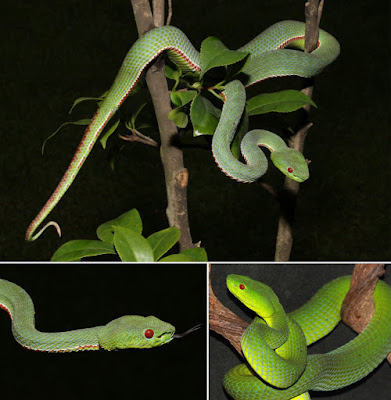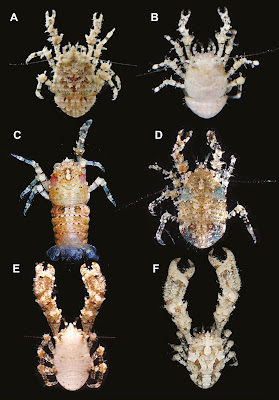[Most Recent Entries] [Calendar View]
Friday, April 5th, 2019
| Time | Event | ||||
| 6:19a | [Herpetology • 2019] Trimeresurus yingjiangensis • A New Species of the Genus Trimeresurus (Squamata: Viperidae) from Southwest China
Abstract Species from the Trimeresurus popeiorum complex (Subgenus: Popeia) is a very complex group. T. popeiorum is the only Popeia species known from China. During the past two years, five adult Popeia specimens (4 males, 1 female) were collected from Yingjiang County, Southern Yunnan, China. Molecular, morphological and ecological data show distinct differences from known species, herein we describe these specimens as a new species Trimeresurus yingjiangensis sp. nov. Chen, Ding, Shi and Zhang. Morphologically, the new species distinct from other Popeia species by a combination of following characters: (1) dorsal body olive drab,without cross bands on the scales; (2) a conspicuous bicolor ventrolateral stripe present on each side of males, first row of dorsal scales firebrick with a white ellipse dot on posterior upper part in male, these strips absent in females; (3) eyes firebrick in both gender; (4) suboculars separated from 3rd upper labial by one scale on each side; (5) ventrals 164–168 (n = 5); (6) MSR 21. Keywords: Popeia; morphology; phylogenetics; geographical isolation; Trimeresurus yingjiangensis sp. nov. Class: Reptilia, Order: Squamata, Suborder: Serpentes, Family: Viperidae Trimeresurus yingjiangensis sp. nov. Chen, Ding, Shi and Zhang Diagnosis. Trimeresurus yingjiangensis sp. nov. is assigned to Popeia group by hemipenes morphology (Malhotra and Thorpe, 2004), differ with its congeners by a combination of following characters: (1) dorsal body olive drab,without cross bands on the scales; (2) a conspicuous bicolor ventrolateral stripe present on each side of males, first row of dorsal scales firebrick with a white ellipse dot on posterior upper part in male, these strips absent in females; (3) the eyes firebrick in both gender; tail red, mottled with green laterally, and the ventrolateral stripes discontinuous on the tail; (4) hemipenes long, reaching 23rd to 25th SC, forked opposite 5-6th SC (n = 4), bifurcated near the base and the sulcus spermaticus split from the apex to basal without spines; (5) 21 DSR at middle body, moderately keeled; VEN = 164–168 (n = 5), SC = 60–76 (n = 5); Sexual dimorphism, the female has more ventrals and fewer subcaudals than males; (6) tail long, with ratios of TaL/TL between 0.199 and 0.219 in male. Etymology. The specific name yingjiangensis refers to the location of type specimens, Yingjiang Country, Yunnan Province, China. The common name is suggested as “Yingjiang Green Pitviper” in English and “Yíng jiāng zhú yè qīng ( 盈江竹叶青 )” in Chinese. Distribution and habitat. Trimeresurus yingjiangensis sp. nov. was found in Yingjiang Country, Yunnan Province. At its typical locality, this species prefers to inhabit in streams about 1 000 meters elevation, and perch on branches waiting for prey (Figure 5). Zening Chen, Liang Zhang, Jingsong Shi , Yezhong Tang, Yuhong Guo, Zhaobin Song and Li Ding. 2019. A New Species of the Genus Trimeresurus from Southwest China (Squamata: Viperidae). Asian Herpetological Research. 10(1); 13-23. DOI: 10.16373/j.cnki.ahr.180062 | ||||
| 2:29p | [Paleontology • 2019] Bromalites from A Turtle-dominated Fossil Assemblage from the Triassic of Poland
Highlights • Studied coprolites provide information on a turtle-dominated Late Triassic ecosystem. • Coprolites were produced by sharks, turtles, theropods, and a sizable herbivore. • Carnivores fed predominantly on fish in this fluvial environment. • The turtle Proterochersis porebensis was likely omnivorous and semiaquatic. • Life habits of early turtles were similar to those typical of extant taxa. Abstract Bromalites (coprolites and possibly some cololites) from a turtle-dominated fossil assemblage from the Upper Triassic of Poland were studied. Bromalites collected at the Poręba site are grouped within four morphotypes (A, B, C, and D) attributable to sharks, medium-sized omnivorous or carnivorous tetrapods (likely turtles), sizable carnivorous archosaurs (likely theropods) and an indeterminate big herbivorous tetrapod (possibly dicynodonts or aetosaurs), respectively. Food residues, abundant eggs (possibly of parasites), and microorganisms were found within the materials. Several lines of evidence suggest that at least part of the type B specimens might have been produced by turtles, since (a) turtles are the prevailing tetrapods in the assemblage (over 4/5 of tetrapod bone remains), (b) coprolites are of adequate size, and (c) they appear to have been produced by a carnivore of a low metabolic rate, as seen in extant turtles. The content of the type B specimens would imply that the Late Triassic turtle Proterochersis porebensis was partly piscivorous, but possibly complemented its diet with a more diversified foodstuff, including plants. Semiaquatic habit of Proterochersis porebensis might also provide a taphonomic explanation of the relative abundance of turtle remains at the Poręba site, Poland. Shark bromalites and coprolite specimens attributable likely to theropod dinosaurs also contain abundant fish remains. Origin and classification of spiral and scroll bromalites left by fish are discussed in addition. Keywords: Coprolites, Early turtle ecology, Feeding habits, Late Triassic, Testudinata
Piotr Bajdek, Tomasz Szczygielski, Agnieszka Kapuścińska and Tomasz Sulej. 2019. Bromalites from A Turtle-dominated Fossil Assemblage from the Triassic of Poland. Palaeogeography, Palaeoclimatology, Palaeoecology. 520; 214-228. DOI: 10.1016/j.palaeo.2019.02.002 | ||||
| 2:32p | [Crustacea • 2019] Corralliogalathea joae, C. minuta & C. parva • High Morphological Similarity Coupled with High Genetic Differentiation in New Sympatric Species of Coral-reef Squat Lobsters (Decapoda: Galatheidae) Abstract The genus Coralliogalathea of the family Galatheidae is easily differentiated from other genera in the family by its small size, the presence of three to four small lateral teeth on the rostrum and the lack of the first pair of gonopods in males. The genus currently consists of only a single species, Coralliogalathea humilis, which lives in close association with corals in the Indian and Pacific Oceans. Using material collected across its distribution, we analysed both morphological characters and molecular markers (COI, 16S, 28S and 18S) to investigate cryptic species diversity, phylogenetic relationships within the genus, and the phylogenetic position of Coralliogalathea within the family Galatheidae. Our results support the validity of the two species previously synonymized with C. humilis and three new sympatric species found in Espiritu Santo, Vanuatu. Although these species are distinguishable only by subtle morphological characters, they are highly dissimilar genetically and constitute relatively deep divergent lineages. Furthermore, phylogenetic analyses of Galatheoidea resolved Coralliogalathea as an ancient genus within the superfamily that most probably diversified during the Eocene. Keywords: Coralliogalathea, molecular data, morphology, new species, squat lobsters Paula C. Rodríguez-Flores, Enrique Macpherson, David Buckley and Annie Machordom. 2019. High Morphological Similarity Coupled with High Genetic Differentiation in New Sympatric Species of Coral-reef Squat Lobsters (Crustacea: Decapoda: Galatheidae). Zoological Journal of the Linnean Society. 185(4); 984–1017. DOI: 10.1093/zoolinnean/zly074 | ||||
| 3:43p | [Herpetology • 2019] Cyrtodactylus nyinyikyawi & C. pyadalinensis • Two More New Species of the Cyrtodactylus peguensis group (Squamata: Gekkonidae) from the Fringes of the Ayeyarwady Basin, Myanmar
Abstract Two new species of Bent-toed Geckos of the Cyrtodactylus peguensis group are described from foothill areas occurring on opposite sides of the Ayeyarwady Basin. Cyrtodactylus nyinyikyawi sp. nov. from the Shwe Settaw Wildlife Sanctuary, Magway Region in the east and C. pyadalinensis sp. nov. from the Panluang-Pyadalin Wildlife Sanctuary, Shan State in the west bear unique suits of morphological and color pattern character states separating them from all species in the peguensis group. Additionally, a molecular phylogeny based on the mitochondrial gene ND2 indicates that neither species is nested within, nor sister to any known species in the group. This study augments recent and ongoing studies showing that the Ayeyarwady Basin is herpetologically more diverse than previously considered and should be incorporated into ongoing discussions concerning conservation efforts in Myanmar. Keywords: Reptilia, gecko, lizard, conservation, Burma, integrative taxonomy Cyrtodactylus pyadalinensis L. Lee Grismer, Perry L. Jr. Wood, Myint Kyaw Thura, Nay Myo Win and Evan S. H. Quah. 2019. Two More New Species of the Cyrtodactylus peguensis group (Squamata: Gekkonidae) from the Fringes of the Ayeyarwady Basin, Myanmar. Zootaxa. 4577(2); 274–294. DOI: 10.11646/zootaxa.4577.2.3 |
| << Previous Day |
2019/04/05 [Calendar] |
Next Day >> |















